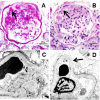Rare hereditary COL4A3/COL4A4 variants may be mistaken for familial focal segmental glomerulosclerosis
- PMID: 25229338
- PMCID: PMC4245465
- DOI: 10.1038/ki.2014.305
Rare hereditary COL4A3/COL4A4 variants may be mistaken for familial focal segmental glomerulosclerosis
Abstract
Focal segmental glomerulosclerosis (FSGS) is a histological lesion with many causes, including inherited genetic defects, with significant proteinuria being the predominant clinical finding at presentation. Mutations in COL4A3 and COL4A4 are known to cause Alport syndrome (AS), thin basement membrane nephropathy, and to result in pathognomonic glomerular basement membrane (GBM) findings. Secondary FSGS is known to develop in classic AS at later stages of the disease. Here, we present seven families with rare or novel variants in COL4A3 or COL4A4 (six with single and one with two heterozygous variants) from a cohort of 70 families with a diagnosis of hereditary FSGS. The predominant clinical finding at diagnosis was proteinuria associated with hematuria. In all seven families, there were individuals with nephrotic-range proteinuria with histologic features of FSGS by light microscopy. In one family, electron microscopy showed thin GBM, but four other families had variable findings inconsistent with classical Alport nephritis. There was no recurrence of disease after kidney transplantation. Families with COL4A3 and COL4A4 variants that segregated with disease represent 10% of our cohort. Thus, COL4A3 and COL4A4 variants should be considered in the interpretation of next-generation sequencing data from such patients. Furthermore, this study illustrates the power of molecular genetic diagnostics in the clarification of renal phenotypes.
Figures




Comment in
-
Pathology vs. molecular genetics: (re)defining the spectrum of Alport syndrome.Kidney Int. 2014 Dec;86(6):1081-3. doi: 10.1038/ki.2014.326. Kidney Int. 2014. PMID: 25427084 Free PMC article.
-
COL4A3/COL4A4 heterozygous mutations with TBMN presenting as focal segmental glomerulosclerosis.Kidney Int. 2015 Apr;87(4):859. doi: 10.1038/ki.2015.38. Kidney Int. 2015. PMID: 25826548 No abstract available.
-
The author replies.Kidney Int. 2015 Apr;87(4):859-60. doi: 10.1038/ki.2015.39. Kidney Int. 2015. PMID: 25826549 Free PMC article. No abstract available.
References
-
- USRDS . U.S. Renal Data System, USRDS 2013 Annual Data Report: Atlas of Chronic Kidney Disease and EndBStage Renal Disease in the United States. National Institutes of Health, National Institute of Diabetes and Digestive and Kidney Diseases; Bethesda, MD: 2013. 2013.
-
- Korbet SM. Treatment of primary FSGS in adults. J Am Soc Nephrol. 2012;23:1769–1776. - PubMed
-
- Ponticelli C, Graziani G. Current and emerging treatments for idiopathic focal and segmental glomerulosclerosis in adults. Expert review of clinical immunology. 2013;9:251–261. - PubMed
-
- Korbet S. Primary focal segmental glomerulosclerosis, in Therapy in Nephrology and Hypertension: A Companion to Brenner and Rector's The Kidney. In: Rj B, Cs W, editors. Therapy in Nephrology and Hypertension: A Companion to Brenner and Rector's The Kidney. Saunders; Philedelphia: 2002.
-
- Winn MP, Conlon PJ, Lynn KL, et al. A mutation in the TRPC6 cation channel causes familial focal segmental glomerulosclerosis. Science (New York, NY) 2005;308:1801–1804. - PubMed
Publication types
MeSH terms
Substances
Grants and funding
- P30 AG028377/AG/NIA NIH HHS/United States
- 1R56DK098135-01/DK/NIDDK NIH HHS/United States
- P30 DK096493/DK/NIDDK NIH HHS/United States
- P30DK096493/DK/NIDDK NIH HHS/United States
- R01 DK094987/DK/NIDDK NIH HHS/United States
- K08DK082495/DK/NIDDK NIH HHS/United States
- K08 DK082495/DK/NIDDK NIH HHS/United States
- RC2 NS070342/NS/NINDS NIH HHS/United States
- R56 AI098588/AI/NIAID NIH HHS/United States
- T32 DK007731/DK/NIDDK NIH HHS/United States
- 1R56AI098588-01A1/AI/NIAID NIH HHS/United States
- RC2 MH089915/MH/NIMH NIH HHS/United States
- RC2MH089915/MH/NIMH NIH HHS/United States
- 5R01DK094987/DK/NIDDK NIH HHS/United States
- 1RC2NS070342-01/NS/NINDS NIH HHS/United States
- R56 DK098135/DK/NIDDK NIH HHS/United States
- 5T32DK0007731/DK/NIDDK NIH HHS/United States
LinkOut - more resources
Full Text Sources
Other Literature Sources
Research Materials

